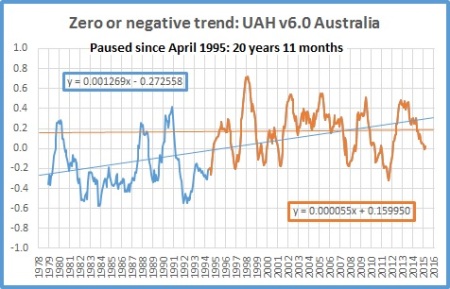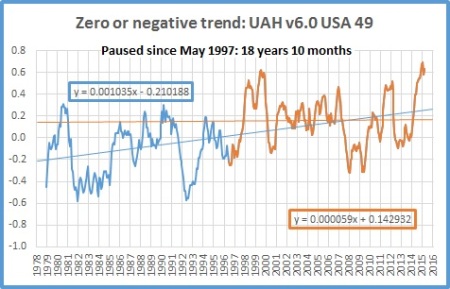The Next Great Global Warming 'Hiatus' Is Coming!
A strange argument from astrophysicist Ethan Siegel below. He admits the recent influence of El Nino and says that recent temperaure upticks therefore prove nothing by themselves. But he adds that the long term trend measured over a century or more is upwards and that THAT is what we should worry about.
He says "But the fact that the global average temperature is rising — and that it continues to rise — is a real long-term problem facing the entire world".
But how does he know that? There has been NO steady rise in temperature in C20. All we can factually say about the 20th century temperature record is that there were some periods of warming and other periods of cooling or stasis. Whether we will have more periods of warming is completely unknown. We could have more periods of cooling that will undo past warming. Nobody knows. He has a sort of paranoid certainty about him that is supported by no data
UPDATE: I must say that I found Siegel's reasoning fascinating -- fascinating in a psychiatric sort of way. I suspect that he may be manic. The file picture of himself that he puts up would be unusual in a well person.

But I will do him the courtesy of taking him seriously and will add a few more comments.
You can certainly put a rising trend line through the C20 temperature record and it appears that Siegel has taken that for reality. It isn't. It is a statistical artifact only. And it does not describe the data well. Perhaps the most striking feature in the data is the long stasis between 1945 and 1975 -- 30 years, almost a third of the record. That totally busts any tale of continually rising temperatures. It makes the C21 "hiatus" of nearly 20 years look ephemeral in comparison.
Warmists of course dismiss the C21 stasis as in some way not meaningful. But how long does it have to be for it to be meaningful? Warmists don't say these days but when the C21 stasis was young, they said it would have to be 15 to 17 years long to represent anything. Now that it has exceeded that mark they no longer put a number on the matter, which reveals their argument as unscientific. If they had any basis for accepting or rejecting meaningfulness, they would be able to put a number on it.
So in that context the 30 year stasis tells us nothing either. But it does. It tells us that the temperatures are unpredictable. It tells us that we do NOT know what the future may bring. But since we are at the end of a warm interglacial, my bet would be on future cooling
Global warming has been occurring at a steady rate for many decades now — possibly for over a century, depending on how you interpret the temperature records — with the past few years setting unprecedented temperature records around the globe. If you go back to 1948-49, the earliest time we’ve had global temperature maps for the entire world, you’ll find that over the vast majority of the Earth, there are more locations seeing the warmest temperatures right now than at any other time. But in terms of “cause for alarm,” what does this actually mean?
The first thing we have to realize is that there are two things at play here: long-term trends, which is the gradual warming we’re seeing over generational timescales, and short-term variations, which are due to things like the seasons, volcanic eruptions, and weather events like El Niño and La Niña. The record-breaking temperatures we’re seeing across the globe are due to a combination of all the short-term and long-term variations superimposed atop one another, and so although last month — February of 2016 — was the hottest month ever recorded, that isn’t necessarily a reason to freak out.
You see, we’re currently experiencing an El Niño event. If you take a look back through the temperature record, many of the largest upward “spikes” you see are due to El Niño years, such as the famous one in 1998. In fact, if you take a look at global average temperatures throughout Februaries, we haven’t had one warmer than the one in 1998 until now.
This peak in temperatures that we’re seeing now, the one that spans from 2015-2016, isn’t due to global warming. That is to say, most of the anomalously high temperatures we’re seeing are due to these short-term variations. But what should be far more concerning to anyone who wants to know the truth about climate change is this: the long-term rise in temperatures is continuing at a steady rate. The fact that temperatures appear to be rising at a rate of between 0.40-0.80 °C (0.72-1.44 °F) per century, unabated, is the real cause for concern. That’s what global warming really is, the slow, long-term rise in temperatures. That’s also the component that humans — through emissions reduction, energy efficiency, renewable power, policy changes and (possibly) geoengineering — can do something about.
But there’s an insidious argument that’s going to come up over the coming years (and possibly the next decade or two), once the current spike in temperature subsides: the idea that global warming will have stopped. Global warming doesn’t just stop. It won’t stop unless there’s a causative reason for it to stop, and — at present — there isn’t one. But because the long-term rise (i.e., the “global warming” component) is gradual, and the short-term variations (i.e., the fluctuations above an below the trend-line) are large, it’s going to appear, over 13-to-17 year timescales, that global warming has ceased.
This is because the long-term rise can be easily masked by short-term variations, and the Berkeley Earth Surface Temperature (BEST) study — the one conducted by global warming skeptics that reached the same conclusions as the rest of the climate science community — reached the following conclusion:
"Some people draw a line segment covering the period 1998 to 2010 and argue that we confirm no temperature change in that period. However, if you did that same exercise back in 1995, and drew a horizontal line through the data for 1980 to 1995, you might have falsely concluded that global warming had stopped back then. This exercise simply shows that the decadal fluctuations are too large to allow us to make decisive conclusions about long term trends based on close examination of periods as short as 13 to 15 years"
There are prominent climatologists who have made these arguments before (who will likely make these arguments again), and they will be quoted in a great many news outlets and by numerous science writers. If you see an article that cites one of them claiming global warming has stopped and it isn’t yet 2033, the 17 years from now that we’re required to wait to see if the rise continues, please refer them back to this article.
Temperature spikes, like the one we’re experiencing now, are temporary, and in all honestly are part of the normal variations we experience over the short term. But the fact that the global average temperature is rising — and that it continues to rise — is a real long-term problem facing the entire world. Don’t let dishonest arguments that gloss over the actual issue dissuade you from the scientific facts. We can fool ourselves into believing that there isn’t a problem until it’s too late to do anything about it, or we can own up to what the science tells us, and face this problem with the full force of human ingenuity. The choice is ours.
SOURCE
 --
-- 






